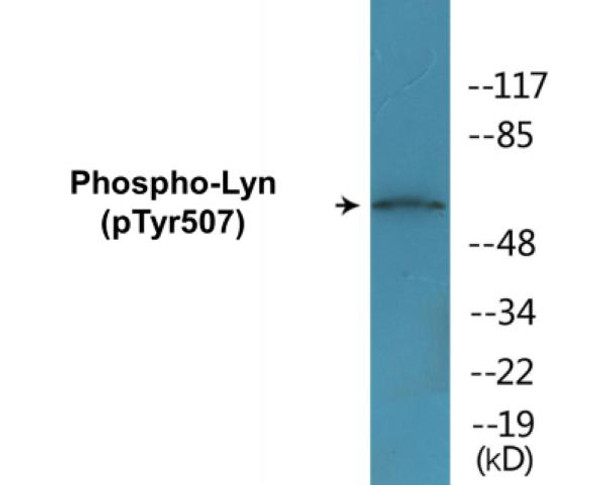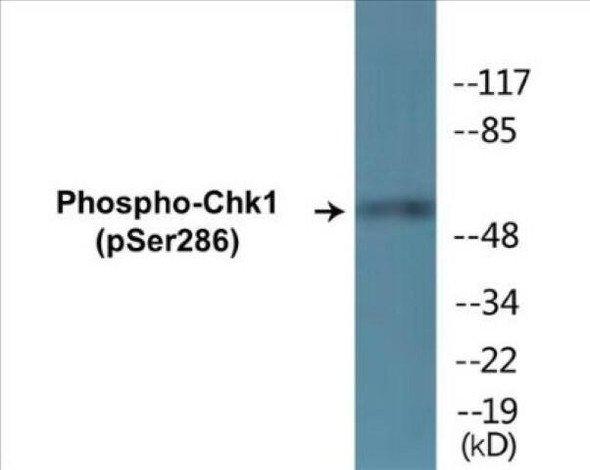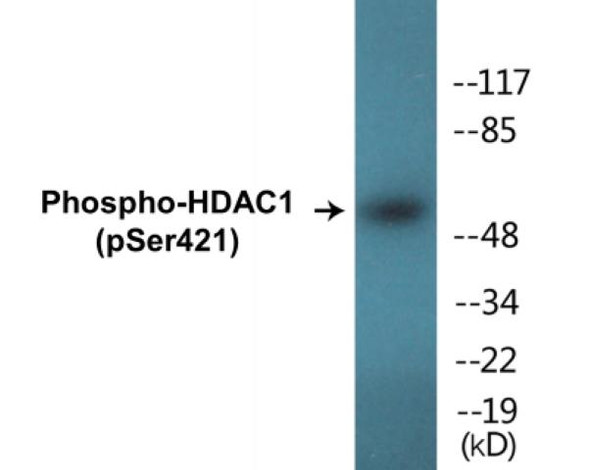Lyn (Phospho-Tyr507) Colorimetric Cell-Based ELISA Kit
- SKU:
- CBCAB01245
- Product Type:
- ELISA Kit
- ELISA Type:
- Cell Based Phospho Specific
- Research Area:
- Immunology
- Reactivity:
- Human
- Mouse
- Rat
- Detection Method:
- Colorimetric
Description
Lyn (Phospho-Tyr507)Colorimetric Cell-Based ELISA Kit
The Lyn (phospho-Tyr507) Colorimetric Cell-Based ELISA Kit is a cutting-edge tool designed to detect and measure levels of phosphorylated Lyn protein in cell lysates, serum, and tissue culture samples. This kit offers high sensitivity and specificity, making it a reliable and precise method for assessing Lyn activation in a variety of biological samples.Lyn is a member of the Src family of protein kinases, and phosphorylation at Tyr507 is known to regulate its activity and function in various cellular processes, including cell growth, differentiation, and immune response. Dysregulation of Lyn signaling has been implicated in several diseases, such as cancer, autoimmune disorders, and inflammatory conditions, making it a valuable target for research and drug development.
By utilizing the Lyn (phospho-Tyr507) Colorimetric Cell-Based ELISA Kit, researchers can gain valuable insights into Lyn signaling pathways and potentially identify new therapeutic targets for treating diseases associated with aberrant Lyn activity. This kit is user-friendly, cost-effective, and delivers accurate results, making it an essential tool for any laboratory studying Lyn protein function and its role in disease pathology.
| Product Name: | Lyn (Phospho-Tyr507) Colorimetric Cell-Based ELISA |
| Product Code: | CBCAB01245 |
| ELISA Type: | Cell-Based |
| Target: | Lyn (Phospho-Tyr507) |
| Reactivity: | Human, Mouse, Rat |
| Dynamic Range: | > 5000 Cells |
| Detection Method: | Colorimetric 450 nm |
| Format: | 2 x 96-Well Microplates |
The Lyn (Phospho-Tyr507) Colorimetric Cell-Based ELISA Kit is a convenient, lysate-free, high throughput and sensitive assay kit that can detect Lyn protein phosphorylation and expression profile in cells. The kit can be used for measuring the relative amounts of phosphorylated Lyn in cultured cells as well as screening for the effects that various treatments, inhibitors (ie. siRNA or chemicals), or activators have on Lyn phosphorylation.
Qualitative determination of Lyn (Phospho-Tyr507) concentration is achieved by an indirect ELISA format. In essence, Lyn (Phospho-Tyr507) is captured by Lyn (Phospho-Tyr507)-specific primary (1ø) antibodies while the HRP-conjugated secondary (2ø) antibodies bind the Fc region of the 1ø antibody. Through this binding, the HRP enzyme conjugated to the 2ø antibody can catalyze a colorimetric reaction upon substrate addition. Due to the qualitative nature of the Cell-Based ELISA, multiple normalization methods are needed:
| 1. | A monoclonal antibody specific for human GAPDH is included to serve as an internal positive control in normalizing the target absorbance values. |
| 2. | Following the colorimetric measurement of HRP activity via substrate addition, the Crystal Violet whole-cell staining method may be used to determine cell density. After staining, the results can be analysed by normalizing the absorbance values to cell amounts, by which the plating difference can be adjusted. |
| Database Information: | Gene ID: 4067, UniProt ID: P07948, OMIM: 165120, Unigene: Hs.699154 |
| Gene Symbol: | LYN |
| Sub Type: | Phospho |
| UniProt Protein Function: | LYN: a tyrosine kinase of the Src family that plays a role in B cell antigen-receptor signaling. |
| UniProt Protein Details: | Protein type:Protein kinase, tyrosine (non-receptor); Kinase, protein; Oncoprotein; Protein kinase, TK; EC 2.7.10.2; TK group; Src family Chromosomal Location of Human Ortholog: 8q13 Cellular Component: cell-cell adherens junction; cytoplasm; cytosol; extrinsic to internal side of plasma membrane; Golgi apparatus; lipid raft; mast cell granule; mitochondrial crista; mitochondrial intermembrane space; nucleus; perinuclear region of cytoplasm; plasma membrane; postsynaptic density Molecular Function:ATP binding; enzyme binding; gamma-tubulin binding; glycosphingolipid binding; integrin binding; non-membrane spanning protein tyrosine kinase activity; phosphoprotein binding; platelet-derived growth factor receptor binding; protein binding; protein-tyrosine kinase activity; receptor binding; receptor signaling protein tyrosine kinase activity; SH3 domain binding; ubiquitin protein ligase binding Biological Process: adaptive immune response; axon guidance; B cell homeostasis; B cell receptor signaling pathway; blood coagulation; cellular response to extracellular stimulus; cytokine secretion; ephrin receptor signaling pathway; erythrocyte differentiation; Fc receptor mediated inhibitory signaling pathway; Fc receptor mediated stimulatory signaling pathway; histamine secretion by mast cell; immune response-regulating cell surface receptor signaling pathway; innate immune response; leukocyte migration; lipopolysaccharide-mediated signaling pathway; negative regulation of B cell proliferation; negative regulation of cell proliferation; negative regulation of immune response; negative regulation of MAP kinase activity; negative regulation of myeloid leukocyte differentiation; negative regulation of protein amino acid phosphorylation; negative regulation of toll-like receptor 2 signaling pathway; negative regulation of toll-like receptor 4 signaling pathway; neurite development; oligodendrocyte development; peptidyl-tyrosine phosphorylation; platelet activation; platelet degranulation; positive regulation of B cell receptor signaling pathway; positive regulation of cell migration; positive regulation of cell motility; positive regulation of cell proliferation; positive regulation of phosphoinositide 3-kinase activity; positive regulation of tyrosine phosphorylation of STAT protein; protein amino acid autophosphorylation; protein amino acid phosphorylation; regulation of B cell apoptosis; regulation of B cell receptor signaling pathway; regulation of cell adhesion mediated by integrin; regulation of cytokine production; regulation of cytokine secretion; regulation of erythrocyte differentiation; regulation of inflammatory response; regulation of mast cell activation; regulation of mast cell degranulation; regulation of protein amino acid phosphorylation; regulation of release of sequestered calcium ion into cytosol; response to amino acid stimulus; response to axon injury; response to carbohydrate stimulus; response to DNA damage stimulus; response to drug; response to hormone stimulus; response to insulin stimulus; response to organic cyclic substance; response to sterol depletion; response to toxin; signal transduction; stimulatory C-type lectin receptor signaling pathway; T cell costimulation; tolerance induction to self antigen; transmembrane receptor protein tyrosine kinase signaling pathway; viral reproduction |
| NCBI Summary: | This gene encodes a tyrosine protein kinase, which maybe involved in the regulation of mast cell degranulation, and erythroid differentiation. Alternatively spliced transcript variants encoding different isoforms have been found for this gene. [provided by RefSeq, Jul 2011] |
| UniProt Code: | P07948 |
| NCBI GenInfo Identifier: | 125480 |
| NCBI Gene ID: | 4067 |
| NCBI Accession: | P07948.3 |
| UniProt Secondary Accession: | P07948,A0AVQ5, |
| UniProt Related Accession: | P07948 |
| Molecular Weight: | 56,033 Da |
| NCBI Full Name: | Tyrosine-protein kinase Lyn |
| NCBI Synonym Full Names: | LYN proto-oncogene, Src family tyrosine kinase |
| NCBI Official Symbol: | LYN |
| NCBI Official Synonym Symbols: | JTK8; p53Lyn; p56Lyn |
| NCBI Protein Information: | tyrosine-protein kinase Lyn |
| UniProt Protein Name: | Tyrosine-protein kinase Lyn |
| UniProt Synonym Protein Names: | Lck/Yes-related novel protein tyrosine kinase; V-yes-1 Yamaguchi sarcoma viral related oncogene homolog; p53Lyn; p56Lyn |
| Protein Family: | Tyrosine-protein kinase |
| UniProt Gene Name: | LYN |
| UniProt Entry Name: | LYN_HUMAN |
| Component | Quantity |
| 96-Well Cell Culture Clear-Bottom Microplate | 2 plates |
| 10X TBS | 24 mL |
| Quenching Buffer | 24 mL |
| Blocking Buffer | 50 mL |
| 15X Wash Buffer | 50 mL |
| Primary Antibody Diluent | 12 mL |
| 100x Anti-Phospho Target Antibody | 60 µL |
| 100x Anti-Target Antibody | 60 µL |
| Anti-GAPDH Antibody | 60 µL |
| HRP-Conjugated Anti-Rabbit IgG Antibody | 12 mL |
| HRP-Conjugated Anti-Mouse IgG Antibody | 12 mL |
| SDS Solution | 12 mL |
| Stop Solution | 24 mL |
| Ready-to-Use Substrate | 12 mL |
| Crystal Violet Solution | 12 mL |
| Adhesive Plate Seals | 2 seals |
The following materials and/or equipment are NOT provided in this kit but are necessary to successfully conduct the experiment:
- Microplate reader able to measure absorbance at 450 nm and/or 595 nm for Crystal Violet Cell Staining (Optional)
- Micropipettes with capability of measuring volumes ranging from 1 µL to 1 ml
- 37% formaldehyde (Sigma Cat# F-8775) or formaldehyde from other sources
- Squirt bottle, manifold dispenser, multichannel pipette reservoir or automated microplate washer
- Graph paper or computer software capable of generating or displaying logarithmic functions
- Absorbent papers or vacuum aspirator
- Test tubes or microfuge tubes capable of storing ≥1 ml
- Poly-L-Lysine (Sigma Cat# P4832 for suspension cells)
- Orbital shaker (optional)
- Deionized or sterile water
*Note: Protocols are specific to each batch/lot. For the correct instructions please follow the protocol included in your kit.
| Step | Procedure |
| 1. | Seed 200 µL of 20,000 adherent cells in culture medium in each well of a 96-well plate. The plates included in the kit are sterile and treated for cell culture. For suspension cells and loosely attached cells, coat the plates with 100 µL of 10 µg/ml Poly-L-Lysine (not included) to each well of a 96-well plate for 30 minutes at 37 °C prior to adding cells. |
| 2. | Incubate the cells for overnight at 37 °C, 5% CO2. |
| 3. | Treat the cells as desired. |
| 4. | Remove the cell culture medium and rinse with 200 µL of 1x TBS, twice. |
| 5. | Fix the cells by incubating with 100 µL of Fixing Solution for 20 minutes at room temperature. The 4% formaldehyde is used for adherent cells and 8% formaldehyde is used for suspension cells and loosely attached cells. |
| 6. | Remove the Fixing Solution and wash the plate 3 times with 200 µL 1x Wash Buffer for five minutes each time with gentle shaking on the orbital shaker. The plate can be stored at 4 °C for a week. |
| 7. | Add 100 µL of Quenching Buffer and incubate for 20 minutes at room temperature. |
| 8. | Wash the plate 3 times with 1x Wash Buffer for 5 minutes each time. |
| 9. | Add 200 µL of Blocking Buffer and incubate for 1 hour at room temperature. |
| 10. | Wash 3 times with 200 µL of 1x Wash Buffer for 5 minutes each time. |
| 11. | Add 50 µL of 1x primary antibodies Anti-Lyn (Phospho-Tyr507) Antibody, Anti-Lyn Antibody and/or Anti-GAPDH Antibody) to the corresponding wells, cover with Parafilm and incubate for 16 hours (overnight) at 4 °C. If the target expression is known to be high, incubate for 2 hours at room temperature. |
| 12. | Wash 3 times with 200 µL of 1x Wash Buffer for 5 minutes each time. |
| 13. | Add 50 µL of 1x secondary antibodies (HRP-Conjugated AntiRabbit IgG Antibody or HRP-Conjugated Anti-Mouse IgG Antibody) to corresponding wells and incubate for 1.5 hours at room temperature. |
| 14. | Wash 3 times with 200 µL of 1x Wash Buffer for 5 minutes each time. |
| 15. | Add 50 µL of Ready-to-Use Substrate to each well and incubate for 30 minutes at room temperature in the dark. |
| 16. | Add 50 µL of Stop Solution to each well and read OD at 450 nm immediately using the microplate reader. |
(Additional Crystal Violet staining may be performed if desired – details of this may be found in the kit technical manual.)










